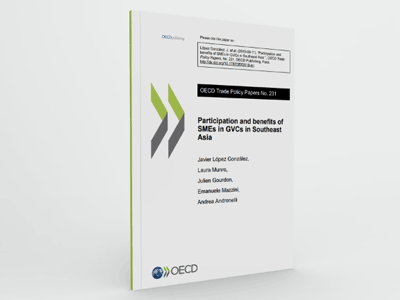Small and medium-sized enterprises and trade
Making it easier for SMEs to trade in the global economy
Across countries at all levels of development, small and medium-sized enterprises (SMEs) play an important role in creating jobs – they employ around 60 to 70% of workers in most countries – and can be an important source of economic activity. There is also evidence that SMEs support greater economic inclusiveness, for example by promoting participation of women as entrepreneurs and in the workforce.
In spite of their contribution to our economies and society today, SMEs tend to be underrepresented in international trade. In particular, they account for a small proportion of exports relative to their share of overall activity and employment. This is in part because SMEs have fewer resources to meet the high costs often associated with engaging in international markets. Smaller firms also face greater challenges than larger firms in navigating foreign markets, with less capacity to address complex regulatory requirements.
The rise of global value chains (GVCs) and the digital transformation offer new opportunities for SMEs to integrate into the global economy. The key question is how governments can create the best policy environment to help SMEs – and the many people they employ – to take advantage of these opportunities.
Global value chains offer new opportunities for SMEs
In recent decades, production has increasingly been fragmented across national borders through GVCs, which allow firms to specialise in different 'tasks' or processes according to their comparative advantage, leading to the production of a final good.
While larger firms and multinationals are by in large the driving force behind GVCs, there are a number of ways in which smaller firms are also participating in, and benefiting from, GVCs. For example, SMEs can take advantage of GVCs by specialising in specific segments of production, rather than having to master all processes required to produce finished goods. SMEs can also benefit from greater flexibility than larger firms, and often have the capacity to customise and differentiate products, responding rapidly to changing market conditions and increasingly shorter product life cycles.
SMEs can engage in GVCs by directly exporting an intermediate good or service to an individual or firm overseas, but they can also participate by indirectly exporting; that is, by supplying multinational or other domestic firms with products that are then exported. But SMEs can also benefit from GVCs through greater access to competitively priced imports, or by receiving knowhow or technology spillovers from the larger (or “lead”) firms they supply.
The digital transformation can help reduce costs associated with engaging in trade
The digital transformation has also given SMEs new avenues to join the global economy, giving rise to a new breed of “born-global” enterprises. Access to digital technologies lowers the barriers of entry into global markets, enabling SMEs to internationalise at a fraction of the cost; digital technologies can thus make it easier for small firms to participate in GVCs, find customers abroad, and make international payments. Promoting digital connectivity, by increasing the quality of digital infrastructure and decreasing the cost of access, will empower smaller firms to take full advantage of the digital trade revolution.
What can policymakers do to help SMEs take advantage of global markets?
While SMEs face many of the same barriers to trade as larger firms, they are often disproportionately impacted by them. This means that when policy makers take steps to lower trade costs, enhance trade facilitation and connectivity, and reduce barriers to trade in goods and services, both SMEs and larger firms will benefit. Detailed guidance on how the policy environment can promote more inclusive GVCs can be found in work undertaken by the OECD with the World Bank and in a more recent review of SME participation in Southeast Asia.
Latest update
Participation and benefits of SMEs in GVCs in Southeast Asia
Although global value chain (GVCs) participation in Southeast Asia has been growing, little is known about whether the benefits from participation are accruing to larger firms or if small and medium sized enterprises (SMEs), which make up the majority of companies and employ the bulk of the domestic workforce, are also able to take advantage of the new opportunities on offer. This paper uses detailed firm level data from Southeast Asian countries to split the OECD Trade in Value Added database and map how SMEs have been participating in GVCs.
Policy brief
SME and trade publications
Access all OECD publications on SMEs and trade on the OECD iLibrary.
Access all trade publications
All of our trade research and analysis is available to read online for free on the OECD iLibrary
Sign-up for our trade newsletter
Sign-up to our newsletter to receive periodic e-mail updates on new publications, videos and analysis.
Contact us with your questions
If you have questions about OECD research and analysis on trade, please feel free to contact us directly.
